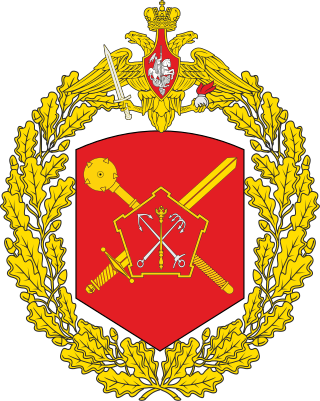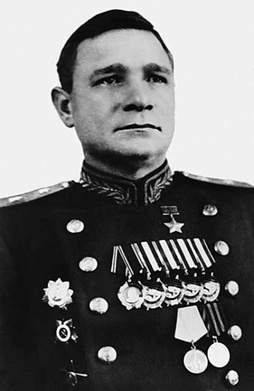World War II
The Leningrad Military District was directed to form the 1st Mechanized Corps from the 20th Heavy Tank Brigade, the 1st and 13th Light Tank Brigades, the 25th Cavalry Division, and the 163rd Rifle Division. The formation of the corps was to be completed by 30 June 1940, but the reorganization was interrupted by the Soviet invasion of Estonia. For the latter, the 13th Light Tank Brigade moved to Pskov by 13 June, assigned to the 8th Army.
The corps was initially formed in March 1940 attached to the Leningrad Military District, and held in reserve near the Pskov Fortified Region. It was under the command of Major General Mikhail Chernyavsky [ ru ] when the German Operation Barbarossa began in June 1941. It initially comprised the 1st and 3rd Tank Divisions, and the 168th Rifle Division [ ru ].
The 3rd Tank Division of the corps was formed from the 13th Light Tank Brigade; the new division inherited the brigade's Order of the Red Banner. The brigade's 6th and 9th Tank Battalions were used to form the 5th Tank Regiment and the 13th and 15th Tank Battalions the 6th Tank Regiment. The period for the formation of the corps was lengthened on 23 June with the extension of the deadline for the completion of the process to 31 July. Despite these delays, the formation of the first new mechanized corps was completed by October and the 1st became one of the most well-manned and -equipped due to the number of units used to form it.
On 22 June 1941, 1st Mechanized Corps consisted of 31,439 men, 1,037 tanks, 239 armored cars, 148 artillery pieces, 146 mortars, 4,730 vehicles, 246 tractors, and 467 motorcycles; including lighter T-26, BT-7, and T-28 model tanks.
After the invasion began, the Leningrad Military District was renamed to the Northern Front and was overseen by Lieutenant General Markian M. Popov. The front fielded the 14th, 7th, and 23rd Armies, the 65th Rifle Corps and the Leningrad Military District forces, including the 2nd Division of NKVD troops. The 1st Mechanized Corps was heavily engaged in the first battles of Operation Barbarossa, particularly during the Baltic Operation (1941). On 29 June 1941, the 1st Mechanized Corps was ordered to reinforce new defenses anchored on the Velikaya River, near Ostrov, on the former Stalin Line after the spectacular advances by Georg-Hans Reinhardt's XLI Panzer Corps, which had crossed the Daugava River. However it was unable to hold the line. On 11 July 1941, Colonel Pavel Poluboiarov [ ru ] on the Northwestern Front reported that the 1st Mechanized Corps had at the present moment fewer than 100 tanks remaining. Pskov and Ostrov were captured within weeks. On 2 August 1941, Colonel Limarenko, Chief of Staff of the 1st Mechanized Corps reported that the Corps possessed no T-34 or KV-1s. When sent into action, only 20 were delivered after combat began. The 1st Mechanized Corps was disbanded in August 1941, although the 1st Tank Division remained in 14th Army.
The Corps was formed a second time on the basis of the 27th Tank Corps on 8 September 1942 in Kalinin. It fought actively during the Second World War from 26 September—10 March 1943, from 9 July 1943—13 January 1944, from 7 June 1944—5 September 1944, and from 30 October 1944—9 May 1945. [8] After the end of World War II, the Corps became part of the Group of Soviet Occupation Forces in Germany.
The 2nd Red Banner Army was a Soviet field army of World War II that served as part of the Far Eastern Front.
A tank corps was a type of Soviet armoured formation used during World War II.
A mechanised corps was a Soviet armoured formation used prior to the beginning of World War II and reintroduced during the war, in 1942.

The 6th Combined Arms Army is a field army of the Red Army and the Soviet Army that was active with the Russian Ground Forces until 1998 and has been active since 2010 as the 6th Combined Arms Army. Military Unit number в/ч 31807.

Alexander Ilyich Lizyukov was a Soviet military leader holding the rank of major-general. He was awarded the title of Hero of the Soviet Union on 5 August 1941.
The 10th Mechanized Corps was a formation in the Soviet Red Army during the Second World War.
The 2nd Mechanised Corps was a formation in the Soviet Red Army during the Second World War.
The 5th Mechanised Corps was a mechanised corps of the Red Army, formed on three occasions. It was first formed in 1934 and was converted into the 15th Tank Corps in 1938. It was reformed in the Far East in 1940 and moved west before the German invasion of the Soviet Union. It fought in the First Battle of Smolensk, losing large numbers of tanks in the Lepel counterattack. The corps was encircled in the Smolensk pocket and after breaking out was disbanded in late August 1941. Its third formation, from elements of the 22nd Tank Corps, occurred in September 1942. The corps fought in: Operation Little Saturn, Operation Gallop, the Second Battle of Smolensk, the Dnieper–Carpathian Offensive, and the Second Jassy–Kishinev Offensive. In September 1944, it became the 9th Guards Mechanised Corps.
The 26th Mechanized Corps was a Mechanized corps of the Red Army. The mechanized corps of the Red Army were reorganized after Operation Barbarossa, the German invasion of the Soviet Union. The corps was reorganized and disbanded before it saw action.

The 7th Mechanized Corps was a mechanized corps of the Red Army, formed three times. The corps was first formed in 1934 in the Leningrad Military District and was converted into the 10th Tank Corps in 1938. The corps was reformed in the summer of 1940 in the Moscow Military District and fought in the Battle of Smolensk, after which its headquarters became part of Group Yartsevo's headquarters. The corps was formed a third time in August and September 1943. The third formation fought in the Dnieper–Carpathian Offensive, Uman–Botoșani Offensive, Second Jassy–Kishinev Offensive, Battle of Debrecen, Budapest Offensive, Bratislava–Brno Offensive, Prague Offensive, and the Soviet invasion of Manchuria. Postwar, the corps' third formation became a division and was disbanded in 1957.
The 11th Mechanized Corps was a mechanized corps of the Red Army, formed twice. The corps was first formed as one of the original two Red Army mechanized corps from the 11th Rifle Division in Leningrad. In 1934 it was transferred to the Transbaikal Military District and in 1938 became the 20th Tank Corps. The corps was reformed in March 1941 in western Belarus. After the German invasion of the Soviet Union, the understrength corps was destroyed in the Battle of Białystok–Minsk.
The 5th Rifle Corps was a corps of the Soviet Union's Red Army, formed twice.

Viktor Ilyich Baranov was a Soviet Army lieutenant general and a Hero of the Soviet Union.
The 13th Light Tank Brigade was an armored brigade of the Red Army that fought in the Winter War.
The 210th Rifle Division was formed as an infantry division of the Red Army after a motorized division of that same number was badly damaged and then redesignated as a cavalry division in the first weeks of the German invasion of the Soviet Union. It served through nearly the remainder of the war on a quiet sector in Transbaikal Front, entirely as part of 36th Army. During July 1945, in the leadup to the Soviet invasion of Manchuria, it was transferred to the 86th Rifle Corps, still in 36th Army. This Army was in the second echelon of the invading forces and saw very little, if any, actual combat, but the division was nevertheless given a battle honor. It was transferred to 17th Army and was disbanded with it by mid-1946.
The 225th Rifle Division was an infantry division of the Red Army, formed in December 1941 from the remnants of the pre-war 3rd Tank Division and based on the shtat of July 29, 1941. The 3rd Tank's single rifle regiment was joined by two reserve rifle regiments, and its howitzer regiment was converted to a standard artillery regiment. As part of 52nd Army in Volkhov Front it took part in largely local fighting in the Novgorod area, seeing combat in several abortive attempts to retake the city until it finally played a main role in its liberation in January 1944 and received its name as a battle honor.
The 229th Rifle Division was an infantry division of the Red Army, originally formed in the months just before the start of the German invasion, based on the shtat of September 13, 1939. As part of 20th Army it was moved from the Moscow Military District to the front west of Orsha by July 2. Serving under the Western Front the 20th was soon pocketed in the Smolensk region but the 229th was able to escape at the cost of significant losses. It was partially rebuilt before the start of the final German offensive on Moscow, when it was completely encircled and destroyed.
The 3rd Mechanized Corps was a mechanized corps of the Red Army. Formed in June 1940 during World War II, the corps was stationed in occupied Lithuania under the Baltic Special Military District. The corps was destroyed in late June 1941 during the Battle of Raseiniai, one of the initial battles of Operation Barbarossa.
The 1st Light Tank Brigade was an armored brigade of the Red Army that fought in the Winter War.
The 198th Rifle Division was formed as an infantry division of the Red Army after a motorized division of that same number was reorganized in the first months of the German invasion of the Soviet Union. It was based on the shtat of July 29, 1941, with several modifications. It entered combat as a rifle division during the Tikhvin Offensive in December 1941 as a reinforcement for 54th Army, helping to drive elements of Army Group North back to the Volkhov River from their earlier gains. It would remain near that river line into early 1944. During 1942 it took part in several abortive offensives in an effort to relieve the siege of Leningrad, suffering heavy losses in one of them. In 1943 it was mainly used for line-holding duties at a reduced establishment, in an area where German forces were strictly on the defensive. The 198th was brought back up to something approaching the current establishment by the start of 1944 and, during the offensive that finally drove Army Group North away from Leningrad, it helped to maintain the offensive's momentum following the initial breakthrough as part of 119th Rifle Corps. It was finally reassigned to 3rd Baltic Front's 67th Army in April after it was halted at the Panther Line near Pskov. In August it briefly returned to 54th Army during the advance through the Baltic States, and after the capture of Riga it remained in western Latvia for the duration of the war, serving under several commands, mostly the 42nd and 10th Guards Armies. It was one of the very few divisions that served throughout the war without receiving any battle honors or decorations. Despite this, the 198th continued its service, now in western Siberia, for another 10 years, before being redesignated as the 23rd Rifle Division.



